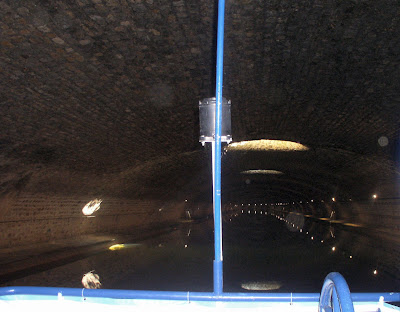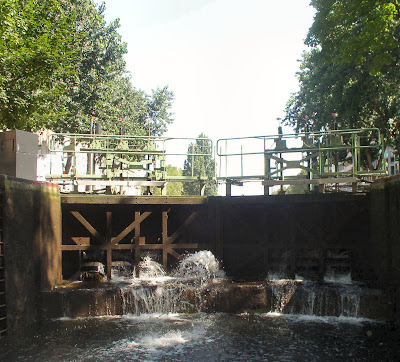Canal Saint-Martin Cruise to Parc de la Villette
Canal Saint-Martin is a 2.86 mile long canal in Paris, connecting the Canal de l’Ourcq with the Seine River. Construction on the canal was ordered by Napoleon I in 1802, and continued until 1825, funded by a new tax on wine. The canal supplied the city of Paris with fresh water to support a growing population. The canal was also used to supply Paris with grain and building materials, carried on canal boats. In the mid-19th century, over nearly half its length was covered to create wide boulevards and public spaces on the surface. By the 1960s, traffic had dwindled to a trickle, and the canal narrowly escaped being filled in and paved over for a highway.
The canal is drained and cleaned every 10–15 years, and it is always a source of fascination for Parisians to discover curiosities and even some treasures among the hundreds of tons of discarded objects.
Today the canal is a popular destination for Parisians and tourists. Some take cruises on the canal in passenger boats. Others watch the barges and other boats navigate the series of locks and pass under the attractive cast-iron bridges. The area has become trendy in recent years, with restaurants and bars along the open part of the canal.
Notre Dame Cathédral on the Seine River
Notre Dame with scaffolding
Notice the small, barred, jail-like window just above the water line at the tip of the island. It is part of the Deportation Memorial, in remembrance of the 200,000 people who were deported from Vichy France to the Nazi concentration camps during World War II. It is located on the site of a former morgue, underground behind Notre Dame on Île de la Cité.
Entry to Canal Saint-Martin There are 9 locks, with a total difference in level of 24 meters. All the locks, with the exception of the lock leading off the Seine, are double staircase locks.
Entry to Canal Saint-Martin from the Seine River
The first lock gives access from the Seine River to the marina and the Canal Saint-Martin.
Arsenal Marina with Place de la Bastille in the distance.
The site takes its name from an arsenal that was here between the 16th and 19th centuries. It was intended to strengthen the defenses of Paris. Its basin was dug and filled with water following the French Revolution.
The Place de la Bastille is a square in Paris where the Bastille prison stood until the storming of the Bastille and its subsequent physical destruction between July 14, 1789, and July 14, 1790, during the French Revolution. No vestige of the prison remains. In the center of the square, the famous July column, "Génie de la Liberté" (Spirit of Freedom) commemorates the revolution of 1830. The canal passes under the square.
Entering the 2.5 km long Bastille tunnel
Écluse du Temple
Canal lock named for the Knights Templar, who once owned land in the area. The Knights Templar was a military order founded in 1118. Templar knights, in their distinctive white mantles with a red cross, were amongst the most skilled fighting units of the crusades.
Second of the Templar locks
The nearby Convent of the Récollets was a former Franciscan monastery, founded by Marie Antoinette in 1614. From 1802, it was used as a military hospital during both world wars and also the Algerian War (1954-1962).
Looking back at the canal
Hôtel du Nord on the quai de Jemmapes
The 1938 movie, Hôtel du Nord, was filmed right facing the Canal Saint-Martin. The bartender recounted how Eugène Dabit, son of the owners of the Hôtel du Nord, wrote the original story in 1929.
Écluse des Morts
On the left of the lock is the quai de Valmy; in the middle is the Locks of the Dead; on the right is the quai des Jemmapes. Near this lock was the site of the Montfaucon gallows, the main gallows of the kings of France until the time of Louis XIII. It was used to execute criminals, often traitors, by hanging and to display their dead bodies as a warning to the population.
Second last lock approaching Parc de la Villette
Last canal lock of the most northerly locks on Canal Saint-Martin
Tour boat, Canauxrama, docked at Parc de la Villette
The Parc de la Villette is the third largest park in Paris, located in the northeastern edge of the 19th arrondissement. The park houses museums, concert halls, live performance stages, as well as playgrounds for children and 35 architectural follies (garden structures.) I have been there twice, once just to walk around and once to see the exhibition “Amazonia.” As the architect intended, the park is a place for activity and interaction rather than for relaxation and observation. I saw many families and also singles gathered together to enjoy their surroundings. It was a park well-used for active, not just passive, participation.
FYI You can rent an electric boat (no license required) and go 20 kilometers on the Canal de l’Ourcq, departing from the Bassin de la Villette. Cost: 27€ per person for a day with friends on the Canal de l’Ourcq for 11 people (you can picnic, play badminton or petanque on the banks, sunbathe or take a nap…) We saw a number of these small, electric four-person boats go by on the canal as we were approaching the end of our cruise.




























No comments:
Post a Comment